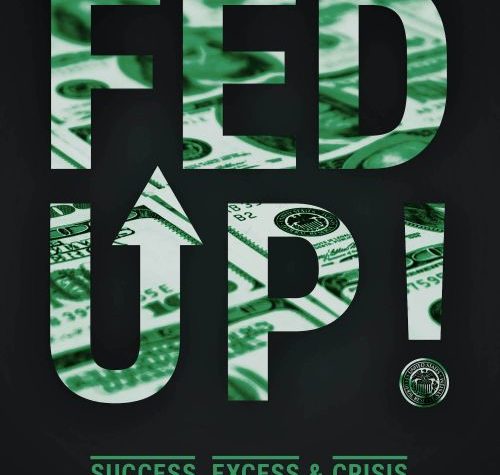Fed Up! A book review by Richard Gill, CFA

According to Barclays, hedge funds around the world managed assets of a huge $4.3 trillion at the end of June this year. That’s more than the annual GDP of Germany, enough to fund the building of 29 International Space Stations and probably just about enough to cover a round of drinks in central London. But despite their size, hedge funds remain a mystery to many people, especially given that they can’t be marketed to regular retail punters in the UK.
For those looking for a deeper insight into the weird world of hedge funds, how they operate and the characters behind them, new book Fed Up! by Colin Lancaster provides just that. Covering the events of the Covid-19 pandemic through 2019 and 2020, the book tells the story of a global hedge-fund macro trader plying his trade during one of the worst market panics of recent times. Beginning during an exuberant bull market and continuing through the spring 2020 crash and on to the early recovery, it provides readers with a ‘fly on the wall’ account of the frantic life of a trader.
Providing the autobiography-like story, Lancaster himself is a Wall Street professional with some 25 years’ experience in the markets. He has run two of the highest-profile, global, macro businesses for the top-performing hedge funds in the world and has worked directly for a number of the ‘icons’ of the investing world.
Hedge your bets
Fed Up! looks at the financial-market events before and during the global pandemic and how Colin Lancaster dealt with them. Part one begins in the late stages of the 2019 bull market, a time when the Federal Reserve was continuing to boost the economy with its aggressive liquidity-pumping exercise, the FANG stocks were flying and stock markets remained strong despite the ongoing Brexit debacle and concerns about the US/China trade war.
Here we are introduced to the world of the hedge-fund macro trader, a job which involves analysing the markets and making big calls based on what you think will happen to fundamental economic factors like inflation and interest rates. A hedge-fund investor can put their money into practically anything they want, as long as at the end of the day they’ve turned a pile of money into an even bigger pile of money. They might even invest in garden hedges if they thought their price would go up.
The first part also sets out the typical routine of a hedge-fund trader. It is a stressful job, but it also comes with benefits like boozy lunches, trips to the casino and of course ‘telephone-number’ salaries. That’s not for everyone however, with some of the top traders instead employing yoga coaches and personal trainers − anything to give them an edge in this cut-throat industry. We are also introduced to some of the characters that Lancaster worked with, including the smooth, fast-talking trader, the hard-working and eager model builder and the obligatory analyst with a funny nickname − the Rabbi.
When China sneezes…
Part two then moves on to the first few months of 2020. With the virus getting out of control in China and spreading worldwide, the financial markets were beginning to panic about the potential for an economic catastrophe. Lancaster first realised the scope of problem via a concerning late-night phone call from one of his Asian brokers. While hedge-fund managers can use any strategy to make money, including by shorting the markets, his portfolio at the time was long on risk and beginning to lose money.
So swift action was needed to manage the risk and stop the negative numbers flashing on the screen, with Lancaster and his team identifying the threats and repositioning accordingly. Threat also brought opportunity, with the chance of catching an inflection point in the market and getting ahead of a change in direction to make some serious money. Unfortunately, the end of February 2020 forced another portfolio review as the markets went into meltdown, with the prices of assets across the board collapsing and global stocks seeing their most extreme sell-off since the Great Financial Crisis. With markets moving so quickly and experiencing extreme volatility, the rest of the section provides an almost daily update of how Lancaster and his team reacted to events.
While the human toll of the pandemic had barely begun, in April 2020 financial markets began to recover as traders saw bargain-basement buying opportunities and as governments around the world started to introduce generous stimulus packages to bolster their plunging economies. Part three looks at the aftermath of the crisis, with markets back into bull territory within only a few months. Of course, the real world economy was still falling fast but as any trader knows, markets do not follow economies.
The book concludes with a concerning juxtaposition. Lancaster ends his journal of the pandemic crash by talking about booking a trip to Las Vegas after the hotels have reopened. By this point he has done his job, making money as a macro trader. But elsewhere, millions of jobs have been lost, thousands are dead and even more wealth has been transferred to the richest people in society. Then again, these are someone else’s problems.
Read up!
Fed Up! is an exciting and informative account of the 2020 market crash from the perspective of someone who lived it out on the front line of the financial markets. In its style, the book echoes Michael Lewis’ Liar’s Poker, the classic semi-autobiographical book which revealed the author’s experiences as a Wall Street bond salesman in the 1980s. As well as being a riveting story, Fed Up! readers will gain an insight into how hedge funds plan their money-making strategies and make trading decisions based on what’s happening in the real world economy. This might prove to be invaluable during the next market crash, which might be coming sooner than you think.
Comments (0)